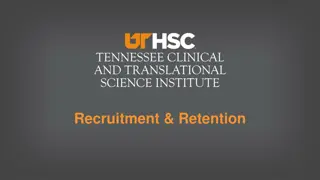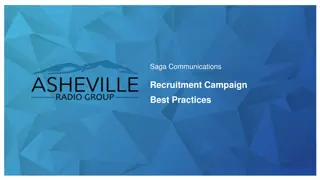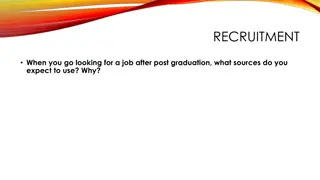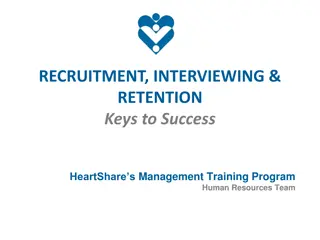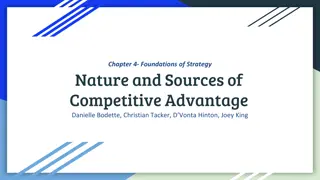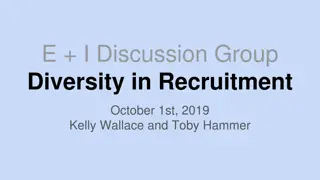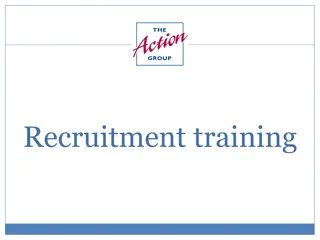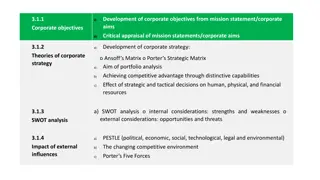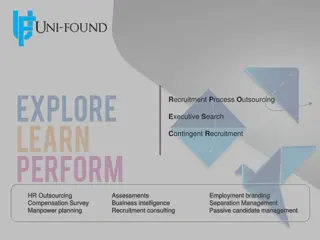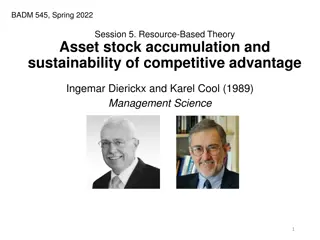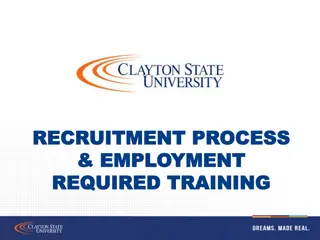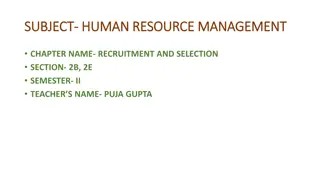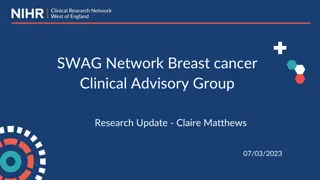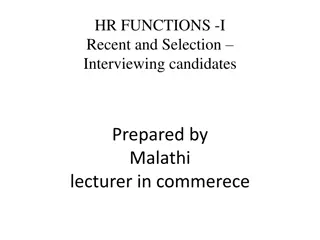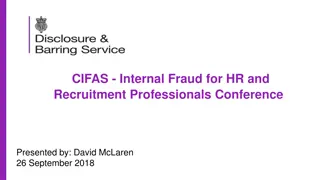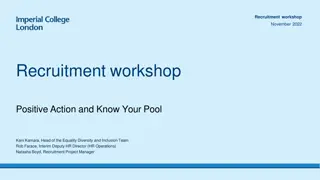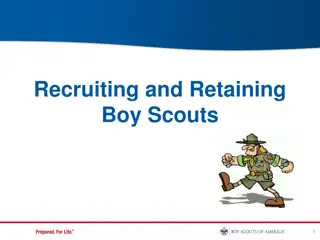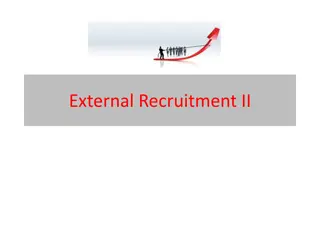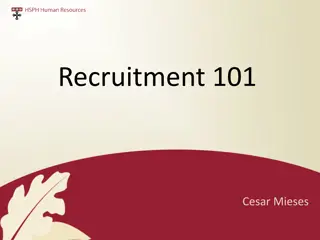Strategic Recruitment in Today's Competitive Environment
Exploring successful recruitment strategies outlined in "RECRUIT.OR.DIE" and "The Concept" to tackle challenges like demographic trends, budget constraints, and heightened expectations. Key elements include identifying target markets, outshining competition, and presenting a united front for effective recruitment. Understand the essence of recruitment, prioritize aspects like strategic planning and ethics, and define your desired candidate profile. Recruitment should align with retention to ensure long-term success.
Download Presentation

Please find below an Image/Link to download the presentation.
The content on the website is provided AS IS for your information and personal use only. It may not be sold, licensed, or shared on other websites without obtaining consent from the author. Download presentation by click this link. If you encounter any issues during the download, it is possible that the publisher has removed the file from their server.
E N D
Presentation Transcript
RECRUIT OR DIE Successful Recruiting Strategies By DJ Menifee, Admission Counselor, Western Illinois University
THE CONCEPT Recruit Or Die: How Any Business Can Beat The Big Guys In The War For Young Talent by Chris Resto, Ian Ybarra & Ramit Sethi You don t have to be the biggest and the most-well known to get the talent you seek What prospects want, what they fear, and what it takes for them to join your organization
RELEVANCE Many of us are facing similar challenges Demographic trends Socioeconomic trends Rising cost Third-party rankings Decreases in budget Heightened expectations Pressure to improve retention & graduation rates Competitive & aspiring peers The Race (Can you keep up?)
QUESTIONS FOR YOU What is recruitment? What is the most important element in recruiting? Who is your competition? Do you have a strategy/plan?
Key Elements For Successful Recruiting Identifying Target Market Selling yourself better than the Competition Working harder & smarter than the Competition Successful Recruitment Present a united front
WHAT IS RECRUITMENT? VP of Enrollment Management at UNC-Steve Farmer Priorities (can t be all things to all people) Strategic Plan Academic programs (STEM) Transfers Ethical Behavior (are your methods ethical?) Teaching/Informing (responsibility to educate) Demonstrating Value Verbalize expectations (pre-retention/ISU) Assessment (how to know what is working) Vision/Leadership narrative (USC-Jerry Lucido) Strategy Accountability Is it sales? Recruitment should be a form of retention in advance
WHO DO YOU WANT? Define who/what you want (Does want and reality match?) Diversity (ethnic, geographic, etc.) Specific populations (international, veteran/military, transfers, OOS) Specific academic programs Academic Profile Admission Criteria (USC case-study example) Level of selectivity Financial Aid (gap, discount, need versus merit) Is campus and the community prepared (VP of EM at Spelman-Arlene Wesley-Cash)? Overall goal and Individual goals Enrollment goals (new freshman ,transfers & retained) Territory goals Know the data (use metrics that measure quality and quantity over time) 80/20 rule (strategies) The best recruiters have the best strategy and hold themselves to the highest standards.
WORK HARDER AND SMARTER THAN THE COMPETITION Know yourself and your competition SWOT Analysis Collect view books Head-hunter versus Gate-keeper (Where are you on the continuum) Institutional knowledge Territory knowledge (Know where to be and why) Be knowledgeable on academic and non-academic trends (regionally and nationally) Sequester Institutions that guarantee meeting need Incentive plans (improve retention and persistence) Summer school (discounting) Partnerships (3+1 at COD) Revamp of the SAT College scorecard Pathway programs Third-party ranking sources Cost-guarantee Technical diploma versus Scholar diploma Pell Grant Job market Go above and beyond the call of duty Prospective student/stakeholder communications Outreach/special interest groups Professional development Adopt what works for you not the competition Master the recruitment/admissions process Compound weekly learning rate The more competitive, exclusive and appealing your process is, the more attractive you ll be to students.
SELL YOURSELF BETTER THAN THE COMPETITION The appearance Match the tone of the environment/tone of institution and its mission Be prepared to speak, meet, and listen to anyone Selling yourself To them, your are the institution Strong communication skills (public speaking, etc.) Competent on social media tools Play to your strengths (for your team and toward prospective students) Accessibility Confidence Be on time Meet them where they are Selling your institution Transparency Strengths/strengths versus competition Know your position in the market The art of storytelling (leverage former success) Outcomes (What they fear) The ability to listen to the audience and their needs Identify the stakeholders It s a waste of time and talent if you end up with reps passing students to another rep that knows their stuff.
PRESENT A UNITED FRONT Commitment, Cooperation & Collaboration Institutional buy-in toward enrollment goals Garnering support (VP of EM at UCLA-Youlanda Copeland-Morgan) Admissions One band, One Sound Utilizing other units in recruitment efforts Faculty Alumni Parents (PFA, Parent/Family weekend, Receptions) Student body (Tour Guides, Panelist, Student Leaders) Financial Aid (What they fear) Senior Administration (leadership) Mascot Importance of coaching, mentoring and professional development The best companies see recruiting as an expertise Execution separates the winners from the losers.
CONCLUSION Identifying Target Market Selling yourself better than the Competition Working harder & smarter than the Competition Successful Recruitment Present a united front
OTHER CONCEPTS IN THE BOOK Prospects: Power of words/gossip The feedback loop: taking incite from past & current students Surveys Institutional Research A successful organization leads to good recruiting, good recruiting leads to a successful organization Making the sale Use of persuasive communication Defining yourself and your goals What are you deeply passionate about? What can you be the best at? How do you measure success? Sell, listen & improve with the best of them.
QUESTIONS FOR YOU Have the important elements in recruiting changed for you? What are your institutions priorities? Are your territory priorities different? Will you change the way you approach the competition? Will you change the way you approach prospective students?


